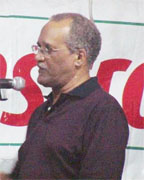One of the important developments in Caribbean drama in the middle of the twentieth century was a phenomenon called the ‘theatre of the backyard’ and sometimes ‘yard theatre.’ Another ‘yard theatre’ emerged in Jamaica between 1968 and 1970, but that was an entirely different movement. This backyard theatre evolved much earlier, rising firstly in Trinidad, but even in the 1960s playwrights were making use of it in various ways. It was one of the early movements that gave shape and identity to the drama of the region.
Several one-act plays and full length dramas came out of it, and many of them have been preserved thanks to the UWI Extra Mural series which collected and published Caribbean plays between the ’50s and ’70s. This type of play got its name from the setting, the communities and colourful characters on which it largely focused. The setting was the ‘backyard,’ also known in Trinidad as the ‘barrack yard,’ in Jamaica as the ‘tenement yard’ or ‘government yard.’ The characters were typical groups of working class elements, the unemployed, the impoverished and the underworld, including petty criminal elements such as small-time con-men. Common among the dramatis personae were racial and cultural stereotypes including Chinese or Portuguese shopkeepers.
These settings and the situations arising from them were products of the colonial societies of the period. The playwrights began by making use of them to highlight the humour that was always generated by the various conflicts and interactions coming out of the co-existence of these people and their challenges. The drama benefited from the response to the conflicts by characters who were mostly unimpeded by inhibitions with a resulting rich source of laughter for the audiences. Comedy was therefore one of the main ingredients in the backyard plays, which made them very popular around the Caribbean.
Moon on a Rainbow Shawl by Trinidadian dramatist Errol John is one of these plays. But it has distinguished itself by its examination of the social and economic situation of the characters, raising several crucial questions about the backyard setting and its colonial context. It takes advantage of the setting to dramatise the tragic side of that existence.
Moon is regarded as one of the best of the backyard plays and goes further to take a place not only among the most popular but among the vintage or ‘classics’ of Caribbean drama. Written in 1957, it remains one of the most frequently performed, suffering nothing from its setting in that particular time period of Trinidad in the late 1940s going into the ’50s after the war when migration to England was growing. It has been popular in Guyana, already performed more than once, including during the ‘Golden Age’ of the Theatre Guild. This performance from November 7-9, 2008 was at least the third revival of the play at that venue in the history of the Playhouse. Some of the best known names in Guyanese theatre have played the popular characters in the previous productions.

This revision of it marks another turning point in that history. It is directed by Ron Robinson who was assisted by Tivia Collins. Robinson, one of the most established names in local theatre, as director, actor and administrator, came out of one of the most productive periods of the Theatre Guild. Tivia Collins represents the most recent developments in this current rebirth of the Guild, and it is no surprise that she worked as an Assistant Director in this production. Part of the mission of this rejuvenated Guild is to train and elevate new talent. That is being done in this production of Moon. In Robinson it had one who is in a position to train and guide, in Miss Collins it inherited one of the most impressive distinction graduates of the recent Carifesta Technical Theatre Training programme, who was Best Director in one of the test pieces. The production manager Denise Hopkinson and some members of the cast were also among those graduates who are now about to make their mark in national theatre.
The production was more expository than experimental, a very clear dramatisation of what the playwright John sought to show. The angsts of the characters were well communicated by a competent cast and a neat production without any extraordinary performances. Notable in the way they worked is how the tragic side of their social situation was emphatically dramatized in the teamwork and how the actors related to each other. Somewhat surprisingly, the comic elements were not given as much emphasis. In most productions of this play it is the other way round, with a main aim to treat the audience to laughter. On the one hand these were strengths of the production but on the other it meant most of the actors did not take advantage of the good and sometimes outrageous humour that the play offered.
Of the lead actresses, Tashandra Inniss as Mavis made the most of these moments. Mavis is a favourite character in this play because she entertains the audience. Inniss managed appropriate gestures and characteristics that defined the prostitute, some of them to the delight of the audience, but avoided the temptation of playing to the gallery. What is more, she successfully negotiated changes of mood and showed different sides of the same character.
Timothy Millington worked well with Inniss in his portrayal of Prince, finding some meaning out of what is a minor character used by Errol John to reflect the effect of the war on the Trinidad environment. A common feature of the period was the presence of an American military base in the island which caused a rise in prostitution and young men like Prince who attached themselves to the base for the odd jobs and easy money that were available.
The female lead, Sophie Adams played by Rudo Blair, was a study of the hard-working wife of an unemployed husband. While she down-played some comic moments, she communicated the harassment felt by the character that causes her in turn to be a harrier of those around her. But she carried the play without difficulty.
John paints a gloomy picture in this drama in many more ways than the plight of Mrs Adams. It comes over in ironies and in characters who fail to get out of the doomed circumstances of poverty and a society that offers no hope. Two new actresses helped to carry this statement in the play: eleven-year-old Esther who was very plausibly played by Shereena Stoby and Rosa, sensitively portrayed by Nirmala Narine. Stoby understood the tension between youthful optimism and the tragic hopelessness of her situation, while Narine quietly represented the other female victim of post-war Port of Spain. She, too, was believable in that role in a fairly unobtrusive way, although the production paid little attention to presenting her as victim, as the object of Ephraim’s ill-treatment.
The problem of Ephraim, played by Orson Smith, is part of the gloomy picture painted in the plot. As an ambitious young man who recognizes the material limitations of what the local society could offer him, he vows to get out of it even if he has to trample on others or crush them to do so. The play comments on emigration to escape these limitations and the cruelty to others inflicted by selfish, single-minded persons like Ephraim. Smith is a competent actor who made this struggle almost heroic in his portrayal to the point where the production de-emphasised the shabby, unmanly treatment of Rosa.
Moon on a Rainbow Shawl, however, is the tragedy of Charley Adams, the irony of whose situation completes the picture of gloom. Established national actor Lionel Whyte did well to play the sometimes cheerful exterior of one who represents the shell that remains after a crushed dream and a dehumanising, class-prejudiced colonial system. Whyte’s acting concentrated on the transition into resignation to inevitable defeat, a mood on which the play ended.
Robinson, who also played another of the stock characters, the exploitative landlord Mr Mac, handled this ending very well with all those who appeared in the last two scenes contributing to the darkness of the conclusion. The best device in an otherwise unremarkable set was the use of the moon that hung there, casting a pale light on the gloom. Both the moon and Rosa’s ironically colourful shawl are symbols in the play which were very effectively used in the end. The way they were combined in this production and assisted by the final focus of the lighting, created a telling picture that illuminated much of the meaning of the play: the hopelessness of romance and dreams amid disappointment and disillusion.









